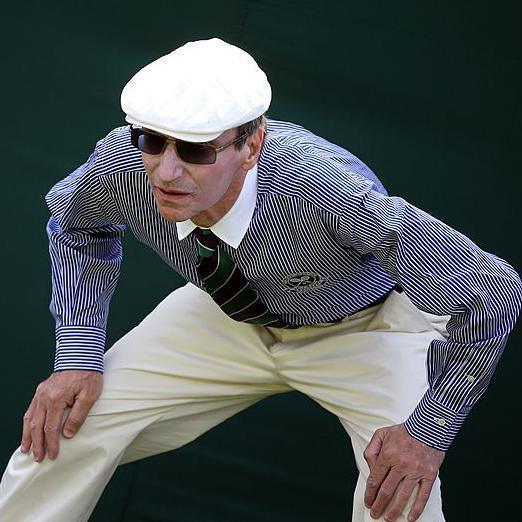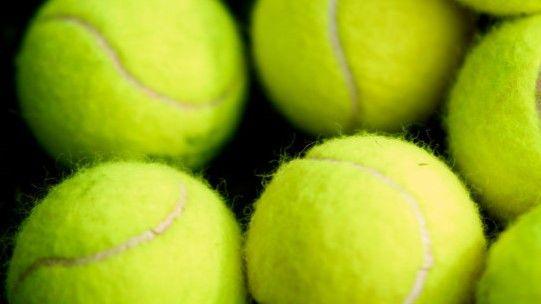
Thomas Sweeney's first incentive to become a line judge was the offer of a free sandwich.
For Pauline Eyre, who called the lines at Wimbledon for 16 years, some natty blazers and the chance to buy tickets for the tournament were the main recompense for work she had to take annual leave to do.
Nowadays the best officials might earn up to £200 a day plus expenses.
But line judging has never been about the money for those who spend hours leaning forward, hands resting on knees, staring intently at a line of chalk to determine in a split second on which side of it the yellow ball has bounced.
Being so close to Jana Novotna on Centre Court that she could see her foot shaking on the first point of a Wimbledon final or being "psyched out" by John McEnroe were priceless experiences for Eyre.
And then there were the outfits.
"There's nothing quite like walking out on to the iconic grass courts at SW19, wearing the uniform of what many consider the best-dressed officials in all of sport," Malgorzata Grzyb, chair of the Association of British Tennis Officials (ABTO), told BBC Sport.
But times have changed. At Wimbledon there will be no line judges for the first time in its 148-year history, with electronic line calling being introduced.
Players and umpires have already got used to the new set-up as it has been at other tournaments for a while, but on the green grass at Wimbledon, where advertising logos are muted and the players are dressed in white, the emptier courts may feel that bit more noticeable.
"It's all the tradition of Wimbledon - the people and the funny uniforms - and that's a bit of personality that's gone," said Eyre. "I think it's all of those little things that made Wimbledon Wimbledon."
Traditionalists will miss them, but technology fans will point to progress.
BBC Sport has been finding out what umpires, players and line judges make of the move.
Will there be line judges at Wimbledon 2025?
- Published26 June
Why does French Open not have electronic line calling?
- Published26 May
Challenges are 'out'
"Mr Djokovic is challenging the call on the right baseline; the ball was called out."
There was often a buzz of excitement when the umpire signalled there would be a video replay of a line judge's decision.
The rhythmic clap-clap-clapping built up to the moment being shown on the big screen, and the obligatory "ooooooooh" followed when the split-second judgement of the human eye was laid bare to a packed arena and millions watching on TV.
More than 14,000 pairs of eyes on Centre Court could bore into the line judge who had been wrong by less than the width of a blade of grass. But when the official was shown to be correct, their poker faces had to fight the urge to look even mildly smug.
This year players can still ask for a replay on the screen, although fans' gasps will be over the depiction of a 'close call' rather than a verdict on human instinct versus technology. And, if recent tournaments are anything to go by, their laughs may be at the delayed reaction for some of the "out" calls.
Paul Hawkins, inventor of the Hawk-Eye technology that was first introduced at Wimbledon in 2007, said the challenge system had probably "had its day" with fans.
"When it was new, there was certainly more excitement – people kind of got into it," he said.
"It got to the point where there was a little bit of a case of 'we've been there, we've had that joke, let's just get on with the tennis' and obviously doing away with the challenge system does mean you can get on with the game a bit quicker."

Some match officials will still be present at Wimbledon to monitor the technology
Some line judges are still 'in'
The absence of line judges now gives players fewer people to take out their frustrations on, with Eyre remembering being "yelled at" by players and being hit by many balls.
Djokovic was disqualified from the 2020 US Open for accidentally hitting a ball at a line judge, while last year Andrey Rublev was defaulted in Dubai for screaming in the face of one.
Not all of the 300 line judges who have been cut will be out of work at Wimbledon, with about 80 being used as 'match assistants' who are on hand in case the technology fails and will also undertake duties such as escorting players who need to leave the court.
But their opportunities to work at big tournaments are dwindling, with the French Open now the only one of the four Grand Slams not using electronic line calling.
The men's ATP Tour and the combined ATP/WTA tournaments introduced the technology this year and WTA-only events are moving in that direction.
Eyre fears this could have an impact on the quality of umpiring in years to come since line judging is a pathway to becoming a chair umpire.
"Why would you go to call the lines at Finchley Tennis Club under-12s if you haven't got that carrot of 'maybe one day I can get to call lines at Wimbledon'?" said Eyre, who called the lines in 12 Wimbledon finals in the 1990s and 2000s and is now a comedian touring a show about her line judge experiences.
However, Grzyb says the development pathway for officials has evolved and stressed that line judges are still used at many events below the top tier of tennis.
"Instead of starting solely as line umpires, new officials now receive training in both line and chair umpiring from the outset, enabling them to progress more rapidly to chair umpire roles," the ABTO chair said.
"[This] is not dissimilar to the systems in place in many countries without a home Grand Slam, and who have been able to produce world-class chair umpires."

Andrey Rublev was defaulted in Dubai for shouting at a line judge
'Out... I think' - You cannot be serious!
Being a line judge usually means being able to stand for a long period of time and, crucially, bellow out the call in a way that makes it obvious what is happening.
As British number one Jack Draper found out at Queen's, the automated calls cannot always be heard over a raucous crowd.
Set point to take his semi-final to a decider was met with confusion as neither Draper nor the crowd were sure whether there had been an "out" call.
With players also no longer able to rely on the line judges' arm gestures to indicate if the ball is out, Eyre says the voices used at the grass-court tournament were not loud enough.
"They have used very calm voices - it sort of sounds like the voice isn't sure," she said.
"Sort of like it's saying 'out… I think'. It feels a bit awkward. That's very different psychologically, not hearing something sharp."
And while some prefer the technology - Briton Heather Watson recently said a bad experience with line judges' calls at Birmingham "ruined the match" - others are unsure.
Compatriot Sonay Kartal said she struggled at the Australian Open as she could hear automated calls from the other courts, leading to confusion and even players stopping the point because they thought the call was on their court.
It is not yet known what the voices of the Wimbledon calls will sound like, with the tournament using the voices of some of its behind-the-scenes staff and tour guides. The All England Club will be using different voices on different courts to avoid confusion between neighbouring courts.
It would have been great if the booming voice of McEnroe himself had been one of the voices, Eyre suggests.
"It would be fun to have McEnroe calling them, wouldn't it? We're all yelling at the telly going 'you cannot be serious!' - I'd like that, we could yell at him and that would be good karma!"
Could umpires be next to go?
First it was a pencil, paper and a stopwatch. Then came an electronic scoring system and next Hawk-Eye.
As technology continues to develop, the need for human intervention diminishes.
So what will go next? Chair umpires?
Seven-time Grand Slam singles champion McEnroe, known for his on-court outbursts, has previously suggested getting rid of umpires and relying on the technology.
Sweeney - he of the free sandwich - is now a chair umpire who oversaw the 2023 women's French Open final.
He has overseen numerous matches on Wimbledon's Centre Court and cannot imagine time being called on umpires in top-level tennis any time soon.
"There will always be that need to have a human to facilitate at the end of where technology has its limitations," Sweeney said.
"There are aspects to life that can't be prepared for, and you need that human to be able to absorb pressure, provide the opportunity for understanding and empathy for a player, and to be able to help, guide and govern how the court itself operates."
But with nine fewer people on court during matches, Sweeney said it "can feel a bit lonely out there" after the "tradition of living the match together and encouraging each other to stay focused".
Ball kids and match officials are still on hand to assist with tasks like fetching towels for players or facilitating bathroom breaks, while one review official monitors the line technology.
"We still have that team," said Sweeney. "Even with smaller numbers, we're still a very strong and supporting team of each other. It just looks a bit different."
Related topics
- Published16 August

